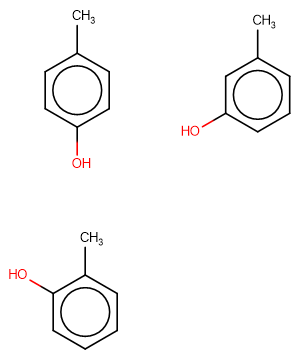
Cresol
CAS No. 1319-77-3
Cresol( Hydroxytoluene | Methylphenol | Tricresol | Cresol mixture of isomers )
Catalog No. M19480 CAS No. 1319-77-3
Cresol is organic compoundis a widely occurring natural and manufactured group of aromatic organic compounds.
Purity : >98% (HPLC)
 COA
COA
 Datasheet
Datasheet
 HNMR
HNMR
 HPLC
HPLC
 MSDS
MSDS
 Handing Instructions
Handing Instructions
| Size | Price / USD | Stock | Quantity |
| 100MG | Get Quote | Get Quote |


|
| 200MG | Get Quote | Get Quote |


|
| 500MG | Get Quote | Get Quote |


|
| 1G | Get Quote | Get Quote |


|
Biological Information
-
Product NameCresol
-
NoteResearch use only, not for human use.
-
Brief DescriptionCresol is organic compoundis a widely occurring natural and manufactured group of aromatic organic compounds.
-
DescriptionCresol is organic compoundis a widely occurring natural and manufactured group of aromatic organic compounds.
-
In Vitro——
-
In Vivo——
-
SynonymsHydroxytoluene | Methylphenol | Tricresol | Cresol mixture of isomers
-
PathwayGPCR/G Protein
-
TargetAntibacterial
-
RecptorAntibacterial
-
Research AreaInflammation/Immunology
-
IndicationInflammation
Chemical Information
-
CAS Number1319-77-3
-
Formula Weight108.14
-
Molecular FormulaC7H8O
-
Purity>98% (HPLC)
-
SolubilityDMSO:72 mg/mL
-
SMILESCc1ccc(O)cc1.Cc1cccc(O)c1.Cc1ccccc1O
-
Chemical NameCresols are organic compounds which are methylphenols. They are a widely occurring natural and manufactured group of aromatic organic compounds which are categorized as phenols.
Shipping & Storage Information
-
Storage(-20℃)
-
ShippingWith Ice Pack
-
Stability≥ 2 years
Reference
1.Meza-Escalante ER et al. J Basic Microbiol. 2015 Feb;55(2):180-5.
molnova catalog



related products
-
Tildipirosin
Tildipirosin is a 16-membered macrolide used as an antibiotic in veterinary medicine. Like other macrolides it inhibits protein synthesis in bacteria and blocks the production of biofilms.
-
Glycol chitosan
Glycol chitosan is a chitosan derivative with hydrophilic ethylene glycol branches.
-
Desvenlafaxine succi...
Desvenlafaxine succinate hydrate is an antidepressant of the serotonin-norepinephrine reuptake inhibitor (SNRI).



 Cart
Cart
 sales@molnova.com
sales@molnova.com


